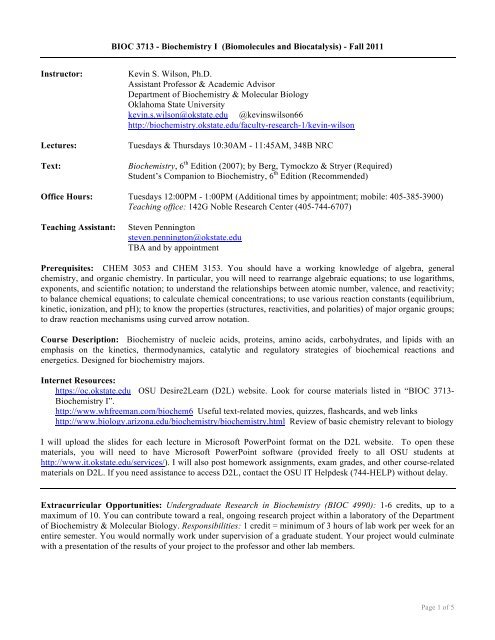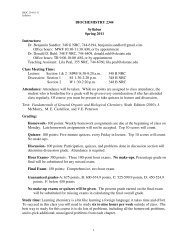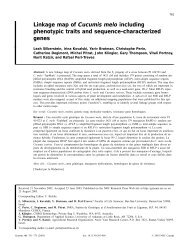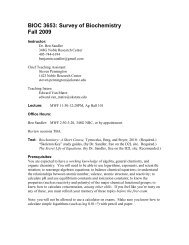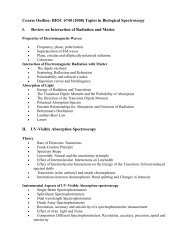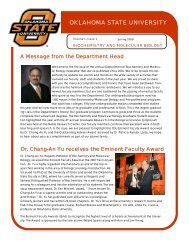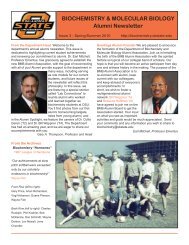BIOC 3713 - Biochemistry I - Biochemistry and Molecular Biology ...
BIOC 3713 - Biochemistry I - Biochemistry and Molecular Biology ...
BIOC 3713 - Biochemistry I - Biochemistry and Molecular Biology ...
Create successful ePaper yourself
Turn your PDF publications into a flip-book with our unique Google optimized e-Paper software.
<strong>BIOC</strong> <strong>3713</strong> - <strong>Biochemistry</strong> I (Biomolecules <strong>and</strong> Biocatalysis) - Fall 2011<br />
Instructor:<br />
Lectures:<br />
Text:<br />
Kevin S. Wilson, Ph.D.<br />
Assistant Professor & Academic Advisor<br />
Department of <strong>Biochemistry</strong> & <strong>Molecular</strong> <strong>Biology</strong><br />
Oklahoma State University<br />
kevin.s.wilson@okstate.edu @kevinswilson66<br />
http://biochemistry.okstate.edu/faculty-research-1/kevin-wilson<br />
Tuesdays & Thursdays 10:30AM - 11:45AM, 348B NRC<br />
<strong>Biochemistry</strong>, 6 th Edition (2007); by Berg, Tymockzo & Stryer (Required)<br />
Student’s Companion to <strong>Biochemistry</strong>, 6 th Edition (Recommended)<br />
Office Hours: Tuesdays 12:00PM - 1:00PM (Additional times by appointment; mobile: 405-385-3900)<br />
Teaching office: 142G Noble Research Center (405-744-6707)<br />
Teaching Assistant:<br />
Steven Pennington<br />
steven.pennington@okstate.edu<br />
TBA <strong>and</strong> by appointment<br />
Prerequisites: CHEM 3053 <strong>and</strong> CHEM 3153. You should have a working knowledge of algebra, general<br />
chemistry, <strong>and</strong> organic chemistry. In particular, you will need to rearrange algebraic equations; to use logarithms,<br />
exponents, <strong>and</strong> scientific notation; to underst<strong>and</strong> the relationships between atomic number, valence, <strong>and</strong> reactivity;<br />
to balance chemical equations; to calculate chemical concentrations; to use various reaction constants (equilibrium,<br />
kinetic, ionization, <strong>and</strong> pH); to know the properties (structures, reactivities, <strong>and</strong> polarities) of major organic groups;<br />
to draw reaction mechanisms using curved arrow notation.<br />
Course Description: <strong>Biochemistry</strong> of nucleic acids, proteins, amino acids, carbohydrates, <strong>and</strong> lipids with an<br />
emphasis on the kinetics, thermodynamics, catalytic <strong>and</strong> regulatory strategies of biochemical reactions <strong>and</strong><br />
energetics. Designed for biochemistry majors.<br />
Internet Resources:<br />
https://oc.okstate.edu OSU Desire2Learn (D2L) website. Look for course materials listed in “<strong>BIOC</strong> <strong>3713</strong>-<br />
<strong>Biochemistry</strong> I”.<br />
http://www.whfreeman.com/biochem6 Useful text-related movies, quizzes, flashcards, <strong>and</strong> web links<br />
http://www.biology.arizona.edu/biochemistry/biochemistry.html Review of basic chemistry relevant to biology<br />
I will upload the slides for each lecture in Microsoft PowerPoint format on the D2L website. To open these<br />
materials, you will need to have Microsoft PowerPoint software (provided freely to all OSU students at<br />
http://www.it.okstate.edu/services/). I will also post homework assignments, exam grades, <strong>and</strong> other course-related<br />
materials on D2L. If you need assistance to access D2L, contact the OSU IT Helpdesk (744-HELP) without delay.<br />
Extracurricular Opportunities: Undergraduate Research in <strong>Biochemistry</strong> (<strong>BIOC</strong> 4990): 1-6 credits, up to a<br />
maximum of 10. You can contribute toward a real, ongoing research project within a laboratory of the Department<br />
of <strong>Biochemistry</strong> & <strong>Molecular</strong> <strong>Biology</strong>. Responsibilities: 1 credit = minimum of 3 hours of lab work per week for an<br />
entire semester. You would normally work under supervision of a graduate student. Your project would culminate<br />
with a presentation of the results of your project to the professor <strong>and</strong> other lab members.<br />
Page 1 of 5
<strong>BIOC</strong> <strong>3713</strong> (Fall 2011): Tentative Schedule of Lectures <strong>and</strong> Exams<br />
Date Lecture Text (chapter.section)<br />
Aug 23 1. Introduction. Chemistry review. Assessment quiz. 1.1 – 1.4<br />
Aug 25 2. Protein composition <strong>and</strong> structure 2.1 – 2.3<br />
Aug 30 3. Protein composition <strong>and</strong> structure 2.4 – 2.6<br />
Sept 1 4. Exploring proteins <strong>and</strong> proteomes 3.1 – 3.3<br />
Sept 6 5. Exploring proteins <strong>and</strong> proteomes 3.4 – 3.6<br />
Sept 8 6. DNA, RNA, <strong>and</strong> the flow of genetic information 4.1 – 4.2<br />
Sept 13 7. DNA, RNA, <strong>and</strong> the flow of genetic information 4.3 – 4.4<br />
Sept 15 Mid-Exam 1 (Lectures 1–7; Text 1.1–4.4)<br />
Sept 20 8. Introduction to RNA synthesis 4.5, 4.7, 29.1<br />
Sept 22 9. Introduction to protein synthesis 4.6, 30.1<br />
Sept 27 10. Introduction to protein synthesis 30.2 – 30.4<br />
Sept 29 11. Exploring genes <strong>and</strong> genomes 5.1 – 5.2<br />
Oct 4 12. Exploring genes <strong>and</strong> genomes 5.3 – 5.4<br />
Oct 6 13. Exploring evolution <strong>and</strong> bioinformatics 6.1 – 6.3<br />
Oct 11 14. Exploring evolution <strong>and</strong> bioinformatics 6.4 – 6.5<br />
Oct 13 Mid-Exam 2 (Lectures 8–14; Text 4.5–6.5, 29.1, 30.1–30.3)<br />
Oct 18 15. Hemoglobin: Portrait of a protein in action 7.1 – 7.2<br />
Oct 20 16. Hemoglobin: Portrait of a protein in action 7.3 – 7.4<br />
Oct 25 17. Enzymes: Basic concepts <strong>and</strong> kinetics 8.1 – 8.3<br />
Oct 27 18. Enzymes: Basic concepts <strong>and</strong> kinetics 8.3 – 8.6<br />
Nov 1 19. Catalytic strategies 9.1 – 9.4<br />
Nov 3 20. Regulatory strategies 10.1 – 10.4<br />
Nov 8 Mid-Exam 3 (Lectures 15–20; Text 7.1–10.4)<br />
Nov 10 21. Carbohydrates 11.1 – 11.4<br />
Nov 15 22. Lipids <strong>and</strong> cell membranes 12.1 – 12.3<br />
Nov 17 23. Lipids <strong>and</strong> cell membranes 12.4 – 12.6<br />
Nov 22 24. Membrane channels <strong>and</strong> pumps 13.1 – 13.3<br />
Nov 24<br />
Thanksgiving (no class)<br />
Nov 29 24. Membrane channels <strong>and</strong> pumps 13.4 – 13.6<br />
Dec 1 26. Signal transduction pathways 14.1 – 14.5<br />
Dec 6 Mid-Exam 4 (Lectures 21–26; Text 11.1 – 14.5)<br />
Dec 8<br />
Review<br />
Dec 13<br />
Final Exam (Cumulative): 10:30AM in 348B NRC<br />
Page 2 of 5
Exams: There will be four mid-term exams during the semester, during regular class time. These exams will test<br />
you primarily on material that was covered in my lectures <strong>and</strong> homework assignments. They may also include some<br />
material from the textbook. The previous page indicates the topics that will be covered on each mid-term exam. The<br />
final exam will be cumulative, covering all material.<br />
To give you an idea of what you can expect, the exam questions will resemble the homework assignments.<br />
Questions will ask you to recall specific facts such as definitions, names, chemical structures, <strong>and</strong> reactions. They<br />
will test your underst<strong>and</strong>ing of biochemistry <strong>and</strong> your ability to reason <strong>and</strong> compute solutions of biochemical<br />
problems, given specific information. To receive credit, you must respond both intelligibly <strong>and</strong> legibly to each<br />
question. During each exam, you will not be permitted to use any outside information, including your textbook,<br />
paper notes, computers, phones, etc. A calculator will only be allowed on certain exams, which I will indicate to<br />
you.<br />
Your top three exam scores will be used in computing your final grade for the course. There will not be any<br />
makeup exams. If you miss an exam, your grade will be determined from your remaining three exams.<br />
Homework: To give you exercise your underst<strong>and</strong>ing of biochemistry, I will assign approximately five sets of<br />
homework problems. I will announce these assignments <strong>and</strong> post them on D2L.<br />
You are encouraged to work together in study groups on these problems. However, your answers to these problems<br />
should be written in your own words. Problems that involve calculations should include all of your reasoning to<br />
arrive at your numerical answer.<br />
Attendance: Your attendance of the lectures is important for you to effectively master biochemistry. Although<br />
attendance is not strictly required, I am required to report attendance history, so I will take a daily class roll.<br />
Starting the second week of class, I will circulate a list of names. You will sign beside your own name. Make sure<br />
you sign in every day, <strong>and</strong> only sign your own name.<br />
Grading Scheme:<br />
points<br />
total points<br />
3 mid-term exams (top scores): 200 600<br />
5 homework assignments: 20 100<br />
final exam: 300 300<br />
course: 1000<br />
You must earn at least 900 points to make an A,<br />
at least 800 points to make a B,<br />
at least 650 points to make a C, <strong>and</strong><br />
at least 500 points to make a D.<br />
How to earn an A in this course: <strong>Biochemistry</strong> is a challenging subject to master. It combines reasoning skills in<br />
chemistry, mathematics, <strong>and</strong> logic with the complexity of biology at the molecular level. Fundamentally, living<br />
processes do obey the laws of chemistry <strong>and</strong> physics. This is the particular power of learning biochemistry.<br />
Therefore, this course will build up from atoms to building blocks (amino acids, nucleotides, sugars, <strong>and</strong> lipids) of<br />
biological polymers (proteins, nucleic acids, carbohydrates, <strong>and</strong> fats). Ultimately, biochemistry has to be presented<br />
in the context of cells, organs, <strong>and</strong> organisms.<br />
While it is almost impossible to remember every fact in the text <strong>and</strong> lectures, I do expect you to know important<br />
chemical structures, reactions, <strong>and</strong> biochemical pathways. I will points these out to you in lectures as the course<br />
progresses, so that you will know what to study for each exam.<br />
More importantly, you should strive to underst<strong>and</strong> the chemical logic of biological molecules <strong>and</strong> reactions.<br />
<strong>Biochemistry</strong> is very much an experimental science, still under rapid development. You will hear about<br />
Page 3 of 5
experimental techniques that are used to obtain some of the facts that described in the text. The homework<br />
assignments are designed particularly to exercise your reasoning skills. You will likely see similar problems on the<br />
exams.<br />
To master biochemistry <strong>and</strong> to earn an A, you should study regularly <strong>and</strong> attentively, as in other courses. Try to<br />
read the assigned sections on the text before each lecture. Review your notes promptly after class, re-read the text,<br />
<strong>and</strong> be sure to see me if your have unresolved questions or need clarifications. For the exams, you should remember<br />
biochemical structures <strong>and</strong> mechanisms, by drawing them on a blank sheet of paper repeatedly from memory.<br />
Finally, practice the assigned problems <strong>and</strong> explore the suggested resources on the internet, to gain a deeper<br />
perspective of biochemistry. Strive to underst<strong>and</strong> the underlying chemical <strong>and</strong> physical logic of biochemistry, <strong>and</strong><br />
you will do very well in this course.<br />
Learning Objectives: As a preview, I have listed below some of the major things that you will learn in this course.<br />
Many concepts <strong>and</strong> terms may not make sense to you now. They should become very clear to you by the end of this<br />
course.<br />
1. Using the Henderson-Hasselbalch equation, determine the charge <strong>and</strong> protonation state of biomolecules in<br />
physiological solution, <strong>and</strong> describe their behavior <strong>and</strong> function in terms of their state.<br />
2. Master the basic principles of protein structures. You will be able to recognize <strong>and</strong> sketch all 20 amino<br />
acids, <strong>and</strong> classify them according to their properties. You will be able to recognize <strong>and</strong> define the folding<br />
of proteins in terms of their primary, secondary, tertiary, <strong>and</strong> quaternary structures. You will be able to<br />
define protein folding in terms of the rotational conformation of the polypeptide backbone <strong>and</strong> interactions<br />
of the amino acid residues. You will be introduced to a variety of experimental techniques for studying<br />
structure <strong>and</strong> function of proteins, including types of chromatography, electrophoresis, mass spectrometry,<br />
X-ray crystallography, <strong>and</strong> NMR spectroscopy.<br />
3. Master the basic principles of nucleic acid structure <strong>and</strong> function. You will be able to recognize <strong>and</strong> sketch<br />
the bases, pairing, <strong>and</strong> backbone of nucleic acids. You will be able to recognize <strong>and</strong> describe the<br />
differences between DNA <strong>and</strong> RNA in both structure <strong>and</strong> function in living cells.<br />
4. Be introduced to the flow of genetic information. You will learn about the genetic code, the biochemical<br />
machineries that transcribe DNA into RNA, <strong>and</strong> translate RNA into protein. You will be introduced to a<br />
variety of experimental techniques for sequencing genomes, cloning genes, <strong>and</strong> regulating gene expression<br />
in bacteria <strong>and</strong> eukaryotic cells.<br />
5. Be introduced to genetic sequence analysis <strong>and</strong> evolution. You will learn about bioinformatic<br />
computations, which are used to classify life forms, identify genes, predict protein structure <strong>and</strong> function,<br />
<strong>and</strong> identify mutational differences that are correlated to human health <strong>and</strong> disease.<br />
6. Visualize <strong>and</strong> underst<strong>and</strong> how the conformational flexibility of proteins regulates their functions. You will<br />
study several case examples, including hemoglobin, myoglobin, myosin, <strong>and</strong> metabolic enzymes.<br />
7. Analyze <strong>and</strong> quantify the kinetics of enzyme reactions. You will learn about mechanisms of enzyme<br />
inhibition <strong>and</strong> regulation.<br />
8. Analyze catalytic mechanisms of enzymes. You will study several case examples, including trypsin,<br />
chymotrypsin, carbonic anhydrases, restriction enzymes, <strong>and</strong> ATPases.<br />
9. Master the basic principles of the structure <strong>and</strong> function of carbohydrates <strong>and</strong> lipids.<br />
10. Be introduced to the components <strong>and</strong> organization of cell membranes. You will learn about phospholipids,<br />
membrane proteins, ion channels, <strong>and</strong> ATPase pumps.<br />
11. Be introduced to signal-transduction pathways. You will learn about hormone receptors, GTPase<br />
amplifiers, <strong>and</strong> cAMP second messengers. You will study a few case examples, including insulin <strong>and</strong> Ras<br />
pathways, <strong>and</strong> correlate defects in them to diabetes <strong>and</strong> cancer.<br />
12. This course will cover a large territory of information, which will lay the groundwork for tackling many<br />
specialized areas of biological science. Therefore, you should strive to underst<strong>and</strong> how biomolecules work<br />
together to carry out the myriad tasks in cells. Hopefully, you will begin to see the unifying chemical logic<br />
that underlies life in all of its great diversity. That is the most important lesson to glean from this course.<br />
Page 4 of 5
Syllabus Attachment: The faculty of OSU is very concerned about your success as a student. The following link<br />
provides answers to questions most often asked by students:<br />
http://academicaffairs.okstate.edu/faculty-a-staff/46-syllabus-attachment<br />
A copy of the <strong>BIOC</strong> <strong>3713</strong> course syllabus <strong>and</strong> the OSU Syllabus Attachment are posted on D2L for your<br />
convenience.<br />
The following points bear repeating …<br />
Academic integrity: Academic dishonesty or misconduct is defined in the Oklahoma State University Policy <strong>and</strong><br />
Procedures Letter 2-0822. You should become familiar with this document as a matter of self-interest. There is<br />
absolutely no tolerance for academic dishonesty or misconduct (without exception). For additional information,<br />
see: http://academicintegrity.okstate.edu/ .<br />
Note: If you are caught plagiarizing on homework or cheating on an exam, the minimum penalty will be zero points<br />
for that document, <strong>and</strong> it will not be dropped from your score for the course. Violations may extend to receiving an<br />
“F” for the course, or suspension from OSU.<br />
Disabilities: If you have special needs, please contact the Office of Student Disability Services (315 Student<br />
Union; http://sds.okstate.edu) as soon as possible, <strong>and</strong> we will provide reasonable accommodations for you.<br />
Important Dates:<br />
Aug 29 Last day to add a course or drop a course with no grade, without instructor permission, <strong>and</strong><br />
100% refund.<br />
Sept 2 Last day to add or drop a course with grade of W, with instructor permission, <strong>and</strong> 50%<br />
Refund.<br />
Nov 11 Last day to drop a course with automatic grade of W, 50% refund.<br />
Dec 2 Last day to withdraw from all courses with an assigned "W" or "F".<br />
Page 5 of 5


